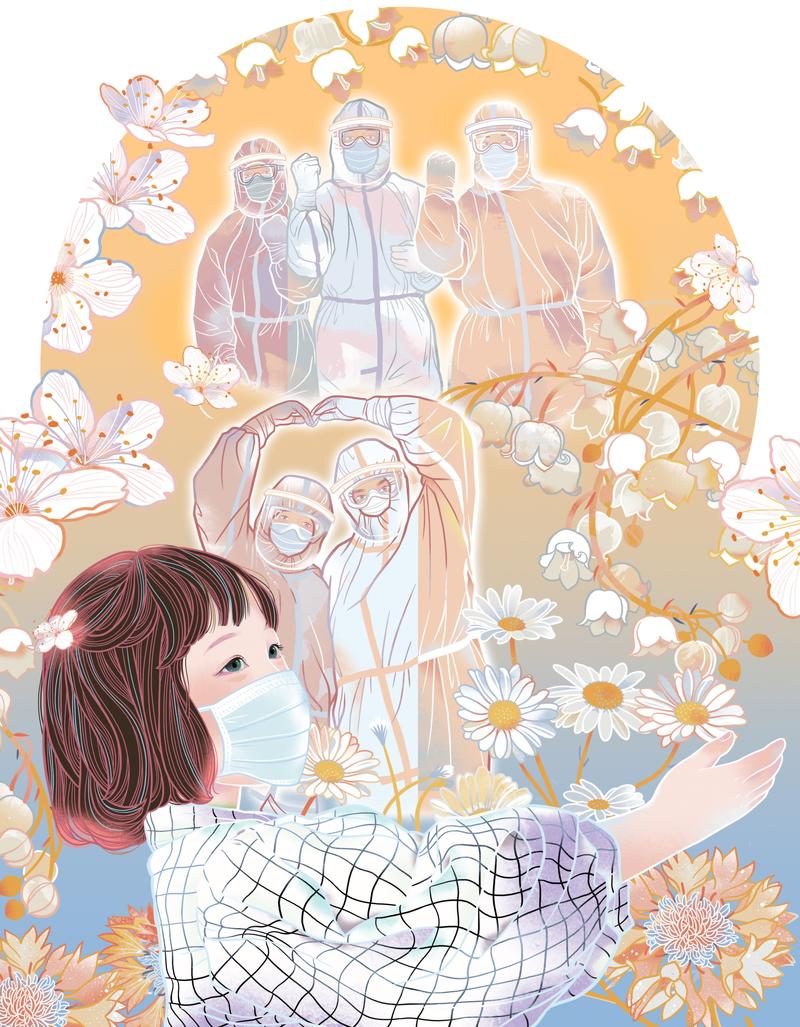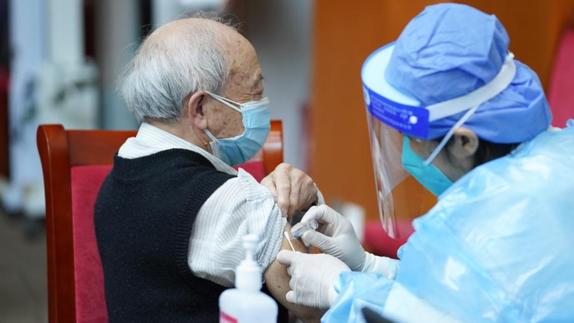Specialists call for safeguarding country's medical system
 (LI MIN / CHINA DAILY)
(LI MIN / CHINA DAILY)
After three years of battling COVID-19, experts said China is seeing the light at the end of the tunnel as it continues to optimize measures against the epidemic.
On Wednesday, the National Health Commission unveiled 10 changes to China's COVID restrictions. The move came less than a month after China introduced its first set of 20 optimization rules to deal with the highly transmissible, but less virulent, Omicron subvariants.
The latest rules include removing the need for negative results of nucleic acid tests and health codes for cross-regional travel and to enter public spaces, with the exceptions of nursing homes, hospitals, kindergartens and other places where there is a concentration of vulnerable people.
People with mild symptoms and asymptomatic cases can now choose to quarantine at home instead of at centralized quarantine facilities. Meanwhile, the purchase of over-the-counter treatments for fever, coughs and colds, as well as antiviral drugs, is no longer restricted.
Speaking at a media briefing on Wednesday, Wang Hesheng, deputy director of the NHC, said that over the past three years, China has stamped out more than 100 flareups and has successfully mitigated five waves of COVID-19, while having one of the lowest levels of infections and COVID-related deaths in the world.
In the meantime, China has issued nine editions of epidemic prevention, control and treatment guidelines, as well as two sets of optimization rules, Wang added. "We have effectively tackled the uncertainties presented by the epidemic with strategic stability and flexible measures," he said.
China now has effective diagnostic methods, contact tracing and treatments, and over 90 percent of the population has been vaccinated. These conditions have protected lives and created an environment conducive to socioeconomic growth, Wang said.
However, some foreign reports said that China's epidemic strategy was slow to react to Omicron, and its triumph over the epidemic is a Pyrrhic victory that has come at great socioeconomic cost. The facts show those claims to be untrue, experts said.
 A medical worker injects COVID-19 vaccine for a senior citizen in Dongcheng district of Beijing, capital of China, April 18, 2022. (PHOTO / XINHUA)
A medical worker injects COVID-19 vaccine for a senior citizen in Dongcheng district of Beijing, capital of China, April 18, 2022. (PHOTO / XINHUA)
Protecting lives
Mao Yonghui, a senior renal doctor at the Beijing Hospital who was tasked with treating severely ill patients in Wuhan, Hubei province, said China's epidemic strategy, although not perfect, has managed to protect the vast majority of people and the economy from the brunt of COVID-19.
According to the World Health Organization, more than 642 million people around the world have been infected with COVID-19, resulting in over 6.62 million deaths.
The WHO data show that despite having 1.4 billion people, a massive elderly population and a relative lack of medical resources compared with developed countries, the Chinese mainland has had only a fraction of COVID cases and deaths compared with countries such as the United States, India, France and Germany.
China's epidemic strategy has been effective, resulting in life expectancy rising from 77.9 in 2020 to 78.2 last year, according to the NHC. This was before the emergence of the Omicron variant, at a time when the early strains of the virus targeted the lungs and had a much higher incidence of severe illness and death.
On the economic front, China was one of the few major economies to see positive growth in 2020, and by last year, its GDP had reached over 114 trillion yuan ($16.3 trillion), registering average growth of 5.1 percent over the two-year period, according to the National Bureau of Statistics.
In May last year, the WHO released a report that highlighted the key global response measures to the COVID-19 pandemic, including building a strong outbreak surveillance system, empowering communities, providing equitable access to tests and treatments, and strengthening the resilience of health systems.
"All these measures are exactly what China has been doing for the past three years," Mao said. "To say China's epidemic policy is rigid and slow is both ignorant and misleading."
Last week, Liang Wannian, a member of the NHC's virus control expert panel, told a media briefing that China has fine-tuned its measures several times over the past three years. "But we must keep in mind that this is a massive, systematic undertaking that requires taking many factors into account," he said.
They include the pathogenic and epidemiological characteristics of the virus, population immunity, the medical system and the COVID-19 situation both at home and abroad, he added.
One of the reasons some Western countries chose to relax control measures earlier was that a large segment of their population had been infected in previous waves of COVID-19 and had therefore acquired immunity. However, this approach cost many lives, Liang said. Another reason was that those countries had high vaccination rates, especially among the elderly population, as well as more medical resources to treat infected people, he said.
However, China has a large aging population, and many of those people have underlying health conditions. Moreover, it doesn't have as many medical resources as Western countries and the inoculation rate among vulnerable citizens, especially seniors, remains low. In addition, China needed time to stock up on medicines and supplies.
Now, many of those limiting conditions have been alleviated or managed, so China has the capacity and resilience to fine-tune its epidemic measures to reflect the changing challenges posed by current variants, thus laying the foundation to overcome the epidemic in the future, Liang said.
Last month, the journal Nature published an article that said vaccinating the elderly, stocking up on antiviral drugs and expanding hospital facilities would help China make the transition to a new phase of the battle against COVID-19.
Xia Gang, an official with the National Administration of Disease Prevention and Control, said in a news briefing on Thursday that the risk of death for unvaccinated people age 80 and older is 14.7 percent, but after three vaccine shots, the figure falls to 1.5 percent.
Xia said China will strengthen medical services to monitor and handle the potential adverse effects for seniors when they receive inoculations, improve efforts to educate the elderly population about the safety and necessity of vaccines, and make it more convenient for older people to receive them.
Jiao Yahui, director of the NHC's Bureau of Medical Administration, said China currently has 138,100 intensive care unit beds, 80,500 ICU doctors and 220,000 specialist nurses for ICUs.
The country also has 106,000 doctors and 177,700 nurses in reserve that can be transferred to serve in ICUs, she said, adding that China will further expand hospital capacity, stock up on medical resources and build more fever clinics.
 Shops are open along a street in Haizhu district of Guangzhou, Guangdong province, on Saturday, following lifting of closed-off management measures across the city, except high-risk areas. (QIU QUANLIN / CHINA DAILY)
Shops are open along a street in Haizhu district of Guangzhou, Guangdong province, on Saturday, following lifting of closed-off management measures across the city, except high-risk areas. (QIU QUANLIN / CHINA DAILY)
Future measures
Speaking at an academic conference on Thursday, Zhong Nanshan, one of China's leading respiratory experts, said the country's epidemic strategy has been very successful, but the fight is not yet over.
"The Omicron variant is highly transmissible, but it is not scary: 99 percent of people can recover fully within seven to 10 days," he said. "The focus of future epidemic control should be treating the severely ill."
Tong Zhaohui, vice-president of the Beijing Chaoyang Hospital, said that there were only four severe cases out of more than 160,000 during the latest outbreak in Guangzhou, Guangdong province. "Omicron spreads much faster than the original strain, but studies and clinical data have proven that it has weaker pathogenesis," he added.
Wang Chen, senior physician and vice-president of the Chinese Academy of Engineering, said the next two to four months will be critical for China as there will likely be a rise in the number of COVID-19 cases.
The appropriate and orderly allocation and use of existing medical resources will be key to controlling the wave of infections, promoting socioeconomic growth and protecting patients' health, Wang added.
During a group interview on Friday, Zhong said models predict that the infection peak will likely arrive late next month and in early February. That will overlap with the 2023 Lunar New Year holidays, which will run from Jan 21 to 27. The event typically prompts the planet's largest annual migration, during which hundreds of millions of people travel to visit their families in their hometowns. Zhong said it is unlikely that China would restrict cross-regional travel during the 2023 holidays, which happened in previous years.
"I advise those traveling home to get booster shots, so that even if they get infected, the symptoms won't be too serious," he said, adding that it takes around one to two weeks for the immunity from the booster shot to take full effect.
Li Lanjuan, a noted epidemiologist, said the Omicron variant primarily targets the upper respiratory tract and causes a less-severe illness than previous strains.
That means most infected people are asymptomatic or have mild symptoms, she said, adding that maintaining personal hygiene, washing hands, taking routine exercise and wearing a mask while outside are effective measures that can shield people from infections.
Zhong Ming, a senior physician at the Zhongshan Hospital in Shanghai, said one of the most important things the public should understand is that not all infected people should go to the hospital.
"We need to safeguard the orderly function of the medical system and prevent it from being overwhelmed. Only those who are truly in need should go to the hospital," he said.
Seniors, late-stage cancer patients, obese people or those with compromised immunity, and those with diabetes, chronic respiratory illness and severe hypertension are more susceptible to becoming severely ill after getting infected with Omicron, he said.
If a patient's temperature stays above 38.5 C for more than three days and doesn't respond well to medication, they should go to the hospital immediately, he said, adding that those who have difficulty breathing or more severe underlying health conditions after becoming infected should also seek medical help.
Outside of those criteria, most people will get better on their own, he said. "After this wave of infections, most people's lives should return to normal. But the virus is still mutating and flare-ups are still possible, so for us medical workers, the battle will likely last longer."


